-
Countries
-
Data and Analysis
-
Special Focus
-
Crisis Responses

Contact
DTM DRC — iomdrcdtm@iom.int
Language
French
Location
Democratic Republic of the Congo
Period Covered
Apr 18 2024
Apr 21 2024
Activity
- Mobility Tracking
- Event Tracking
Depuis le 20 mars 2024, une montée des eaux a été constatée au lac Tanganyika, à la marée de Niangara et aux débordements des rivières Mulongwe, Kalimabenge, Kamvimvira et Kabimba dans la ville d’Uvira, communes de Kalundu, Mulongwe et Kavinvira de la zone de santé d’Uvira. Ces inondations ont affecté sept quartiers (Kalundu, Namianda, Kimanga, Rombe 1 & 2, Kasenga, Kanvinvira), entraînant la destruction de biens, notamment des habitations et des terres agricoles avoisinantes. Les résidents touchés ont été contraints de se réfugier dans des zones non touchées situées dans les quartiers de Kavinvira, Kasenga, Kakombe, Rombe 1, Kimanga, Nyamyanda, Kalundu et Kabimba des communes de Kavinvira, Mulongwe et Kalundu à Uvira. Un total de 6 861 Ménages de 34 358 Individus déplacés internes dont 6 530 Ménages de 32x594 individus en familles d’accueils et 331 ménages de 1 764 Personnes dans les centres collectifs. Plus de 2 800 maisons ont été inondées lors de cet événement. Les dégâts se sont étendus à 17 écoles primaires, 20 écoles secondaires, 7 écoles maternelles et 3 universités, ainsi qu’à 9 églises locales. De plus, plus de 800 robinets d’eau potable ne fonctionnent plus correctement. Les inondations ont également touché 5 marchés importants (le Marché de Frontière, le Marché Tumaini Africa, le Marché Kunzira, le marché Zaïrois et le Marché Maendeleo). Les ports de Kalundu et de Kasenga (Port de Gaby) ainsi que la plage Maendeleo ont été submergés par les eaux. Selon les estimations, plus de 120 hectares de terres agricoles ont été inondés.

Contact
DTM Sudan; dtmsudan@iom.int
Language
English
Location
Sudan
Period Covered
Apr 12 2024
Apr 17 2024
Activity
- Mobility Tracking
- Baseline Assessment
Overview
On 15 April 2023, armed clashes erupted between the Sudanese Armed Forces (SAF) and the Rapid Support Forces (RSF) in multiple cities across Sudan. Clashes initially took place in cities across Northern and Khartoum states, later spreading across the Darfur and Kordofan regions.
Highlights
- DTM Sudan estimates that 6,720,136 individuals (1,338,746 households) were displaced internally since 15 April 2023.
- The IDP caseload was observed in 7,230 locations across all of Sudan’s 18 states.
- The highest proportions of IDPs were hosted across South Darfur (11%), River Nile (10%), and East Darfur (10%).
- Field teams reported that the IDPs observed were originally displaced from twelve states. The majority (3,564,619 IDPs, 53%) were reportedly displaced from Khartoum state; followed by South Darfur (15%), Aj Jazirah (10%), North Darfur (9%), Central Darfur (4%), West Darfur (4%), South Kordofan (2%), East Darfur (1%), West Kordofan (1%), North Kordofan (1%), Sennar (1%) and White Nile (<1%).
- IOM-DTM also reported that an estimated 2,063,976 mixed cross-border movements were made into neighbouring countries.
- This product provides brief insights into those displaced in Sudan post-15 April 2023. For more granular information on the IDP caseload and the displacement context, please see IOM-DTM's One Year of Conflict: Visualizing the World's Largest Displacement Crisis.
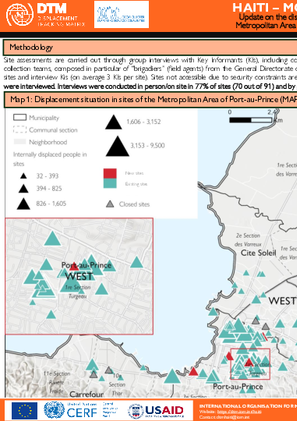
Contact
dtmhaiti@iom.int
Language
English
Location
Haiti
Period Covered
Apr 16 2024
Apr 20 2024
Activity
- Mobility Tracking
In order to continuously inform humanitarian responses in the sites of the ZMPP, the CCCM cluster and the DTM conduct regular data collections in these sites to update basic information on the displacement situation in the sites.
This report presents the situation as of 20 April 2024. A total of 85 sites are active in the ZMPP, hosting 90,254 IDPs. This represents a 1.4% increase compared to the last update on April 4.
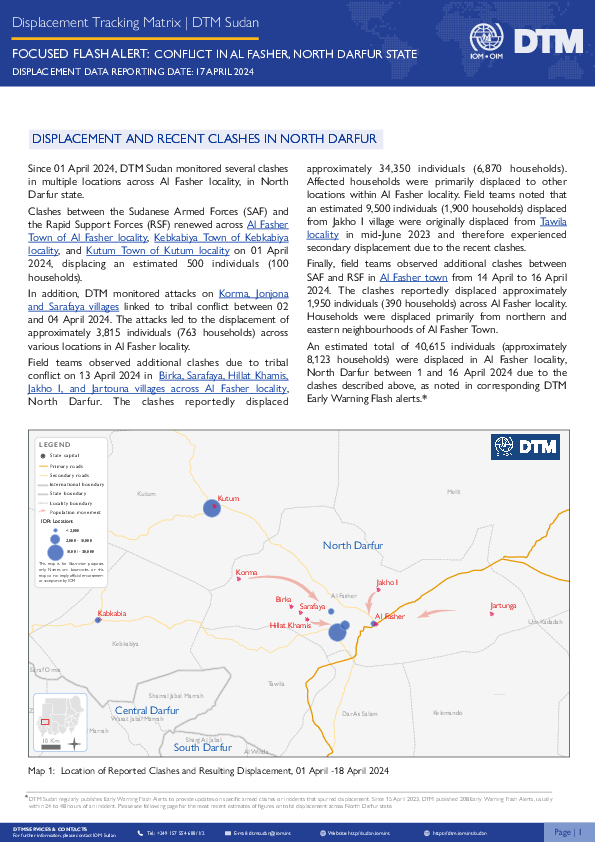
Contact
DTM Sudan, DTMSudan@iom.int
Language
English
Location
Sudan
Period Covered
Apr 01 2024
Apr 17 2024
Activity
- Mobility Tracking
- Baseline Assessment
Since 01 April 2023, DTM monitored numerous clashes across Al Fasher and other localities in North Darfur state. According to DTM field teams, clashes triggered widespread displacement across North Darfur state. As of 18 April 2023, approximately 40,615 individuals (approximately 8,123 households) were displaced in Al Fasher locality due to the numerous clashes since the beginning of the month.
The Focused Flash Alert provides a numeric breakdown of population estimates affected by the recent escalations from 01 April -18 April 2024. All figures should be understood as preliminary estimates, pending further verification.

Contact
dtmuganda@iom.int
Language
English
Location
Uganda
Period Covered
Feb 19 2024
Mar 19 2024
Activity
- Flow Monitoring
Over the reporting period, a total of 15,885 movements were observed at five Flow Monitoring Points (FMPs) through random interviews with travelers. These locations were chosen strategically as major transit points for monitoring movements in and out of Nakivale refugee settlement and from the border between Uganda and the Democratic Republic of Congo through Nyakabande Transit Center. In the reporting period (19 February, 2024 - 19 March, 2024) the majority of movements from Nakivale settlement were outgoing flows at 59% against incoming flows (at 41%). Forty-four per cent of the observed movements were refugees at the five FMPs.
The means of transport commonly used was foot at 37%). Other means used included; motor bike & bike (28%), taxi or car (23%), truck (8%), bus (2%) and others (2%). Most of the flows were due to economic reasons at 29%). Other reasons for the movements included; family reasons (15%) and return (14%). Most of the movements were observed at the Nakivale check point FMP representing 52%) followed by Busanza at 18%), Bunagana (17%), Rugaaga (8%) and Nyakabande transit centre (5%).
Vulnerabilities among the travelers was mostly registered among children under five at 6%), pregnant and/lactating mother at 6%) and the elderly (at 1%).
Out of the 4,531 movements driven by economic reasons, 60% were business related activities such as one-off market transactions, sales/purchases, meetings, and business trips. 29% of the movements were regular daily or weekly travel for work or livelihood activities (including commuting and mining). Additionally, 10% of the movements were motivated by job opportunities, while the remaining 1% fell into other categories.

Contact
DTM Europe, DTMMediterranean@iom.int
Language
English
Location
Serbia
Period Covered
Mar 01 2024
Mar 31 2024
Activity
- Survey
- Flow Monitoring
Ovaj izveštaj pruža uvid u profile, iskustva i putovanja migranata koji prolaze kroz Republiku Srbiju.
Podaci su prikupljani od 1. do 31. marta 2024. godine u saradnji sa Komesarijatom za izbeglice i migracije Republike Srbije (Komesarijat). Uzorak čine 262 intervjuisana migranta.

Contact
DTM Europe, DTMMediterranean@iom.int
Language
English
Location
Serbia
Period Covered
Mar 01 2024
Mar 31 2024
Activity
- Survey
- Flow Monitoring
This report provides insights into the profiles, experiences and journeys of migrants transiting through the Republic of Serbia.
Data was collected from 1 to 31 March 2024 together with the Commissariat for Refugees and Migrants of the Republic of Serbia (SCRM). The sample consists of 262 interviewed migrants.
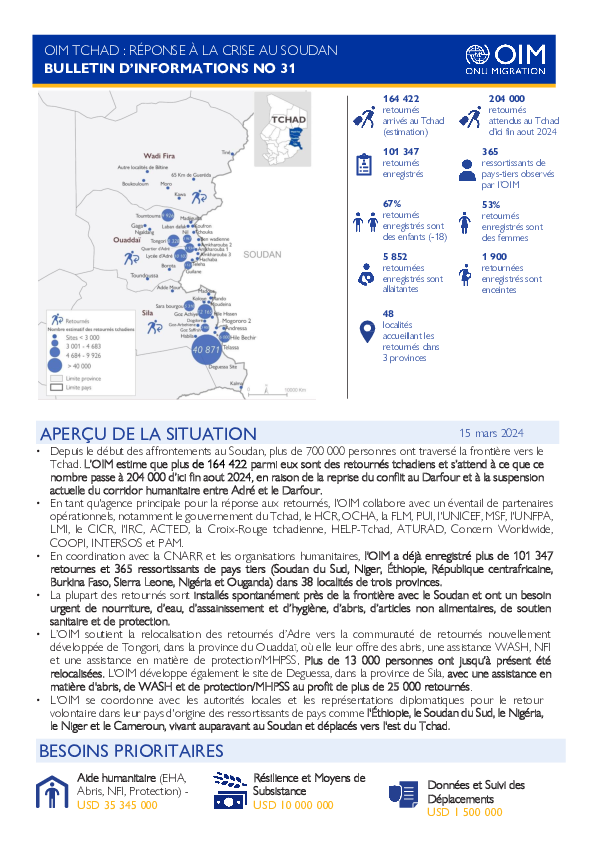
Contact
DTM Chad, dtmtchad@iom.int
Language
French
Location
Chad
Period Covered
Feb 24 2024
Mar 10 2024
Activity
- Mobility Tracking
- Event Tracking
• Depuis le début des affrontements au Soudan, plus de 700 000 personnes ont traversé la frontière vers le Tchad. L’OIM estime que plus de 164 422 parmi eux sont des retournés tchadiens et s’attend à ce que ce nombre passe à 204 000 d’ici fin aout 2024, en raison de la reprise du conflit au Darfour et à la suspension actuelle du corridor humanitaire entre Adré et le Darfour.
• En tant qu'agence principale pour la réponse aux retournés, l'OIM collabore avec un éventail de partenaires opérationnels, notamment le gouvernement du Tchad, le HCR, OCHA, la FLM, PUI, l'UNICEF, MSF, l'UNFPA, LMI, le CICR, l'IRC, ACTED, la Croix-Rouge tchadienne, HELP-Tchad, ATURAD, Concern Worldwide, COOPI, INTERSOS et PAM.
• En coordination avec la CNARR et les organisations humanitaires, l'OIM a déjà enregistré plus de 101 347 retournes et 365 ressortissants de pays tiers (Soudan du Sud, Niger, Éthiopie, République centrafricaine, Burkina Faso, Sierra Leone, Nigéria et Ouganda) dans 38 localités de trois provinces.
• La plupart des retournés sont installés spontanément près de la frontière avec le Soudan et ont un besoin urgent de nourriture, d’eau, d’assainissement et d’hygiène, d’abris, d’articles non alimentaires, de soutien sanitaire et de protection.
• L’OIM soutient la relocalisation des retournés d’Adre vers la communauté de retournés nouvellement développée de Tongori, dans la province du Ouaddaï, où elle leur offre des abris, une assistance WASH, NFI et une assistance en matière de protection/MHPSS. Plus de 13 000 personnes ont jusqu’à présent été relocalisées. L'OIM développe également le site de Deguessa, dans la province de Sila, avec une assistance en matière d'abris, de WASH et de protection/MHPSS au profit de plus de 25 000 retournés.
• L'OIM se coordonne avec les autorités locales et les représentations diplomatiques pour le retour volontaire dans leur pays d'origine des ressortissants de pays comme l'Éthiopie, le Soudan du Sud, le Nigéria, le Niger et le Cameroun, vivant auparavant au Soudan et déplacés vers l'est du Tchad.
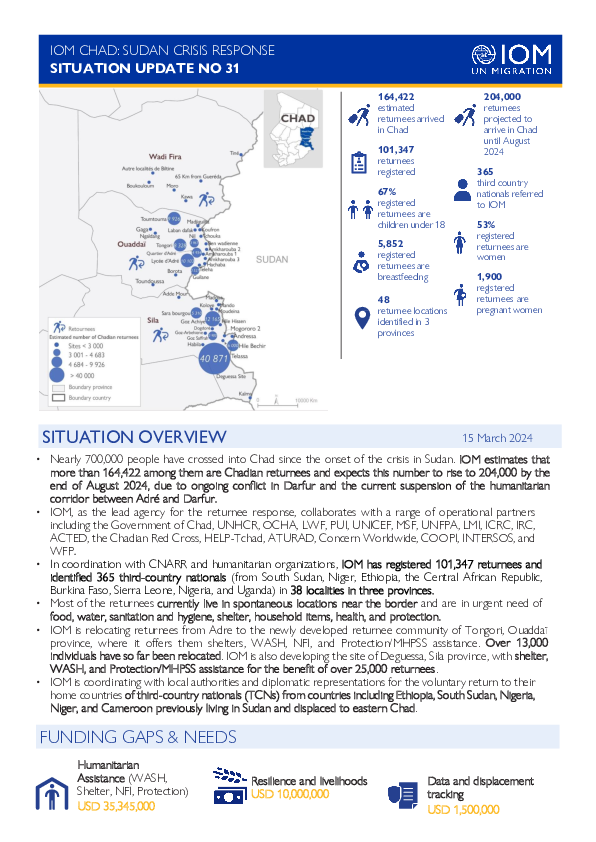
Contact
DTM Chad, dtmtchad@iom.int
Language
English
Location
Chad
Period Covered
Feb 25 2024
May 13 2024
Activity
- Mobility Tracking
- Event Tracking
• Nearly 700,000 people have crossed into Chad since the onset of the crisis in Sudan. IOM estimates that more than 164,422 among them are Chadian returnees and expects this number to rise to 204,000 by the end of August 2024, due to ongoing conflict in Darfur and the current suspension of the humanitarian corridor between Adré and Darfur.
• IOM, as the lead agency for the returnee response, collaborates with a range of operational partners including the Government of Chad, UNHCR, OCHA, LWF, PUI, UNICEF, MSF, UNFPA, LMI, ICRC, IRC, ACTED, the Chadian Red Cross, HELP-Tchad, ATURAD, Concern Worldwide, COOPI, INTERSOS, and WFP.
• In coordination with CNARR and humanitarian organizations, IOM has registered 101,347 returnees and identified 365 third-country nationals (from South Sudan, Niger, Ethiopia, the Central African Republic, Burkina Faso, Sierra Leone, Nigeria, and Uganda) in 38 localities in three provinces.
• Most of the returnees currently live in spontaneous locations near the border and are in urgent need of food, water, sanitation and hygiene, shelter, household items, health, and protection.
• IOM is relocating returnees from Adre to the newly developed returnee community of Tongori, Ouaddaï province, where it offers them shelters, WASH, NFI, and Protection/MHPSS assistance. Over 13,000 individuals have so far been relocated. IOM is also developing the site of Deguessa, Sila province, with shelter, WASH, and Protection/MHPSS assistance for the benefit of over 25,000 returnees.
• IOM is coordinating with local authorities and diplomatic representations for the voluntary return to their home countries of third-country nationals (TCNs) from countries including Ethiopia, South Sudan, Nigeria, Niger, and Cameroon previously living in Sudan and displaced to eastern Chad.
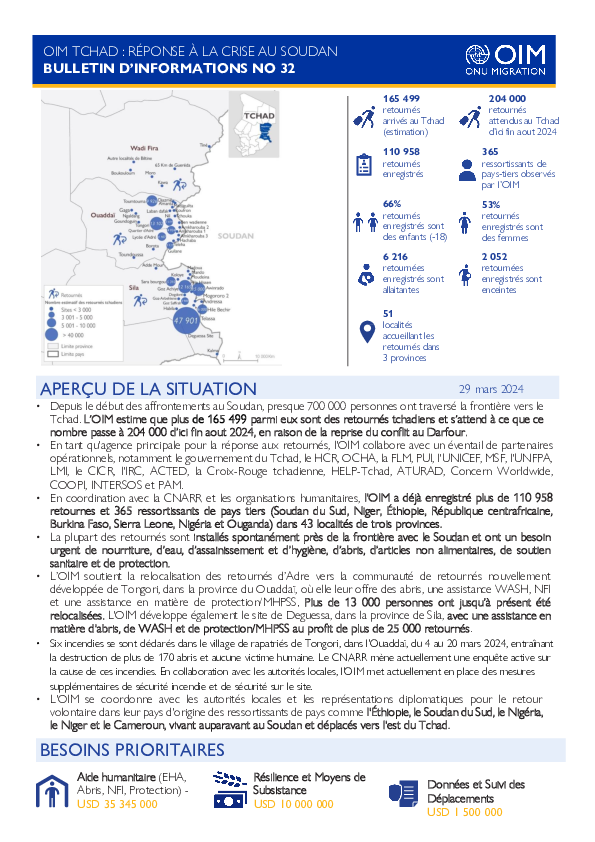
Contact
DTM Chad, dtmtchad@iom.int
Language
French
Location
Chad
Period Covered
Feb 25 2024
Mar 24 2024
Activity
- Flow Monitoring
• Depuis le début des affrontements au Soudan, presque 700 000 personnes ont traversé la frontière vers le Tchad. L’OIM estime que plus de 165 499 parmi eux sont des retournés tchadiens et s’attend à ce que ce nombre passe à 204 000 d’ici fin aout 2024, en raison de la reprise du conflit au Darfour.
• En tant qu'agence principale pour la réponse aux retournés, l'OIM collabore avec un éventail de partenaires opérationnels, notamment le gouvernement du Tchad, le HCR, OCHA, la FLM, PUI, l'UNICEF, MSF, l'UNFPA, LMI, le CICR, l'IRC, ACTED, la Croix-Rouge tchadienne, HELP-Tchad, ATURAD, Concern Worldwide, COOPI, INTERSOS et PAM.
• En coordination avec la CNARR et les organisations humanitaires, l'OIM a déjà enregistré plus de 110 958 retournes et 365 ressortissants de pays tiers (Soudan du Sud, Niger, Éthiopie, République centrafricaine, Burkina Faso, Sierra Leone, Nigéria et Ouganda) dans 43 localités de trois provinces.
• La plupart des retournés sont installés spontanément près de la frontière avec le Soudan et ont un besoin urgent de nourriture, d’eau, d’assainissement et d’hygiène, d’abris, d’articles non alimentaires, de soutien sanitaire et de protection.
• L’OIM soutient la relocalisation des retournés d’Adre vers la communauté de retournés nouvellement développée de Tongori, dans la province du Ouaddaï, où elle leur offre des abris, une assistance WASH, NFI et une assistance en matière de protection/MHPSS. Plus de 13 000 personnes ont jusqu’à présent été relocalisées. L'OIM développe également le site de Deguessa, dans la province de Sila, avec une assistance en matière d'abris, de WASH et de protection/MHPSS au profit de plus de 25 000 retournés.
• Six incendies se sont déclarés dans le village de rapatriés de Tongori, dans l'Ouaddaï, du 4 au 20 mars 2024, entraînant la destruction de plus de 170 abris et aucune victime humaine. Le CNARR mène actuellement une enquête active sur la cause de ces incendies. En collaboration avec les autorités locales, l'OIM met actuellement en place des mesures supplémentaires de sécurité incendie et de sécurité sur le site.
• L'OIM se coordonne avec les autorités locales et les représentations diplomatiques pour le retour volontaire dans leur pays d'origine des ressortissants de pays comme l'Éthiopie, le Soudan du Sud, le Nigéria, le Niger et le Cameroun, vivant auparavant au Soudan et déplacés vers l'est du Tchad.